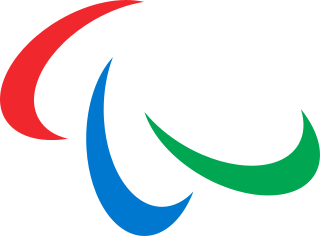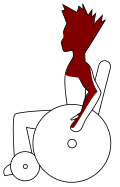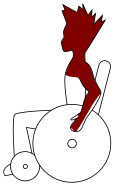
The Paralympic sports comprise all the sports contested in the Summer and Winter Paralympic Games. As of 2020, the Summer Paralympics included 22 sports and 539 medal events, and the Winter Paralympics include 5 sports and disciplines and about 80 events. The number and kinds of events may change from one Paralympic Games to another.
T35 is a disability sport classification for disability athletics' running competitions. It includes people who have coordination impairments such as hypertonia, ataxia and athetosis. This includes people with cerebral palsy. The classification is used at the Paralympic Games. The corresponding F35 classification includes club and discus throw, shot put, and javelin.
Disability sports classification is a system that allows for fair competition between people with different types of disabilities.
C3 is a para-cycling classification. The class includes people with moderate upper or lower limb dysfunctions and includes cyclists with cerebral palsy, limb impairments and amputations. The UCI recommends this be coded as MC3 or WC3. The class competes at the Paralympic Games.
C4 is a para-cycling classification. It includes people with lower limb impairments or issues with lower limb functionality. Disability groups covered by this classification include people with cerebral palsy, amputations and other lower limb impairments. The responsibility for this classification passed from the IPC to the UCI in September 2006.
H1 is a para-cycling classification. It includes people with a number of disability types including spinal cord injuries and cerebral palsy. Handcycles that can be used by people in races include the AP2 recumbent and AP3 recumbent. The classification competes at the Paralympic Games and has international rankings done by the UCI.
Para-athletics classification is a system to determine which athletes with disabilities may compete against each other in para-athletics events. Classification is intended to group together athletes with similar levels of physical ability to allow fair competition. Classification was created and is managed by the International Paralympic Committee (IPC), which is regularly published via its IPC Athletics Classification Handbook. People with physical, vision and intellectual disabilities are eligible to compete in this sport at the Summer Paralympics. The classification for this sport was created during the 1940s and for much of its early history was a medical condition based classification system. The classification system has subsequently become a functional mobility based one, and is moving towards an evidence-based classification system.
Para-swimming classification is a function-based classification system designed to allow for fair competition in disability swimming. The classes are prefixed with "S" for freestyle, butterfly and backstroke events, "SB" for breaststroke and "SM" for individual medley events. Swimmers with physical disabilities are divided into ten classes based on their degree of functional disability: S1, S2, S3, S4, S5, S6, S7, S8, S9 and S10. The lower number indicates a greater degree of impairment. Those with visual impairments are placed in classes S11, S12 and S13. Class S15 is for athletes with hearing loss. Additional classes may be reserved for swimmers with intellectual impairment: S14, S18 for swimmers with Down Syndrome or class-S14 intellectual impairment combined with a physical impairment, and S19 for swimmers with autism.
Para-alpine skiing classification is the classification system for para-alpine skiing designed to ensure fair competition between alpine skiers with different types of disabilities. The classifications are grouped into three general disability types: standing, blind and sitting. Classification governance is handled by International Paralympic Committee Alpine Skiing. Prior to that, several sport governing bodies dealt with classification including the International Sports Organization for the Disabled (ISOD), International Stoke Mandeville Games Federation (ISMWSF), International Blind Sports Federation (IBSA) and Cerebral Palsy International Sports and Recreation Association (CP-ISRA). Some classification systems are governed by bodies other than International Paralympic Committee Alpine Skiing, such as the Special Olympics. The sport is open to all competitors with a visual or physical disability. It is not open to people with intellectual disabilities.

Para-Nordic skiing classification is the classification system for para-Nordic skiing which includes the biathlon and cross-country events. The classifications for Para-Nordic skiing mirrors the classifications for Para-Alpine skiing with some exceptions. A functional mobility and medical classification is in use, with skiers being divided into three groups: standing skiers, sit skiers and visually impaired skiers. International classification is governed by International Paralympic Committee, Nordic Skiing (IPC-NS). Other classification is handled by national bodies. Before the IPC-NS took over classification, a number of organizations handled classification based on the type of disability.

Para-archery classification is the classification system for para-archery used to create a level playing field for archers with a different range of disabilities. Governance in the sport is through the International Archery Federation. Early classification systems for the sport were created during the 1940s and based on medical classification. This has subsequently changed to a functional mobility classification with the exception of blind archery.
Paralympic powerlifting classification is the system designed for disability based powerlifting to insure that there is level competition across a range of disabilities. Categories are broken down based on weight. The sport's classification is governed by International Paralympic Committee Powerlifting. People with physical disabilities are eligible to compete in this sport.
Paralympic Shooting classification is the shooting classification in place for the Paralympic Games to help establish fair competition. Classification is governed by the International Paralympic Committee's IPC Shooting. While there are currently three classifications, there were originally five in international competitions. People with physical disabilities as defined by the International Paralympic Committee are eligible to compete.
Disability table tennis classification is the disability sport classification process for para table tennis that is governed by the International Table Tennis Federation. The sport's classifications are open to people with physical and intellectual disabilities.
Para-equestrian classification is a system for para-equestrian sport is a graded system based on the degree of physical or visual disability and handled at the international level by the FEI. The sport has eligible classifications for people with physical and vision disabilities. Groups of eligible riders include The sport is open to competitors with impaired muscle power, athetosis, impaired passive range of movement, hypertonia, limb deficiency, ataxia, leg length difference, short stature, and vision impairment. They are grouped into five different classes to allow fair competition. These classes are Grade I, Grade II, Grade III, Grade IV, and Grade V(Grade Names Changed as of Jan 2017). The para-equestrian classification does not consider the gender of the rider, as equestrines compete in mixed gender competitions.
Boccia classification is the classification system governing boccia, a sport designed specifically for people with disabilities. Classification is handled by Cerebral Palsy International Sports and Recreation Association. There are four classifications for this sport. All four classes are eligible to compete at the Paralympic Games.
Football 7-a-side classification is the classification system governing Football 7-a-side. The classifications are governed by the Cerebral Palsy International Sports and Recreation Association (CP-ISRA).

Para-equestrian is an equestrian sport governed by the International Federation for Equestrian Sports (FEI), and includes two competitive events. One is para-equestrian dressage, which is conducted under the same basic rules as conventional dressage, but with riders divided into different competition grades based on their functional abilities. The other is para-equestrian driving, which operates under the same basic rules as combined driving but places competitors in various grades based on their functional abilities.
CP8 is a disability sport classification specific to cerebral palsy. In many sports, it is grouped inside other classifications to allow people with cerebral palsy to compete against people with other different disabilities but the same level of functionality.
Cerebral palsy sport classification is a classification system used by sports that include people with cerebral palsy (CP) with different degrees of severity to compete fairly against each other and against others with different types of disabilities. In general, Cerebral Palsy-International Sports and Recreation Association (CP-ISRA) serves as the body in charge of classification for cerebral palsy sport, though some sports have their own classification systems which apply to CP sportspeople.










